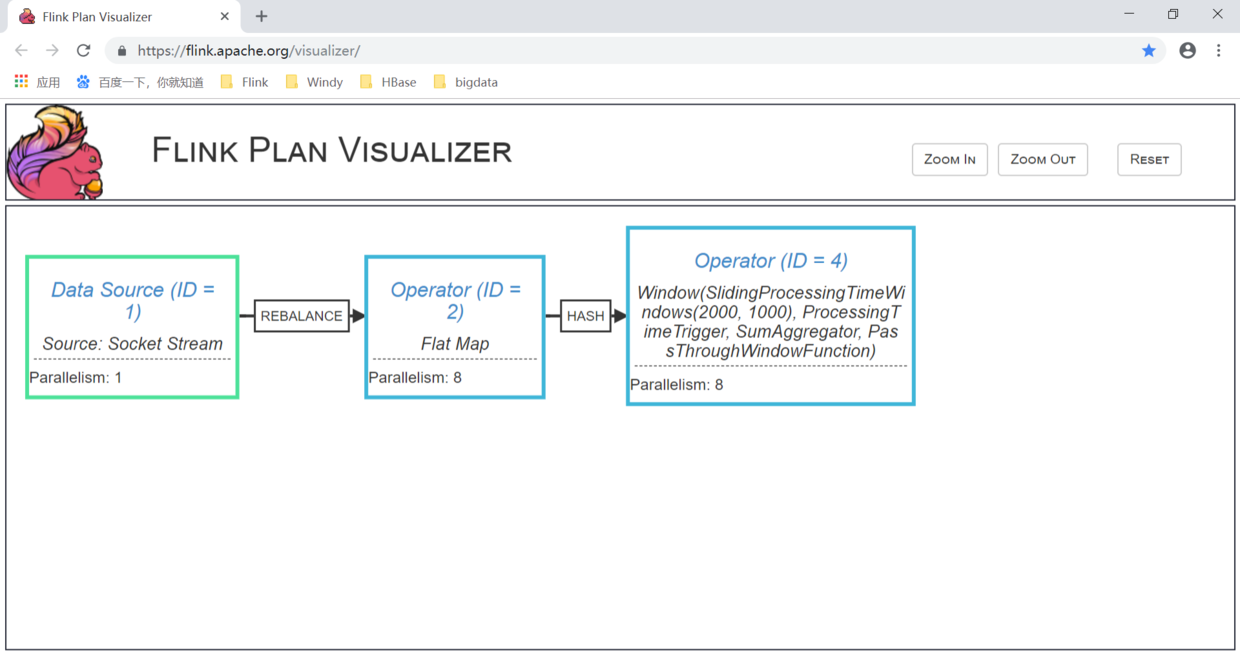Flink 初体验

一、flink介绍
Apache Flink 是一个开源的分布式流处理和批处理系统。Flink 的核心是在数据流上提供数据分发、通信、具备容错的分布式计算。同时,Flink 在流处理引擎上构建了批处理引擎,原生支持了迭代计算、内存管理和程序优化。
二、部署环境
操作系统环境:
flink支持Linux, Mac OS X, 和 Windows环境部署,本次部署选择Linux环境部署。
JDK: 要求Java 7或者更高
三、下载软件
jdk1.8.0_144
flink-1.4.2-bin-hadoop26-scala_2.11.tgz
四、部署步骤
1、JDK安装步骤此处省略,安装后验证下JDK环境
$ java -versionopenjdk version "1.8.0_144"OpenJDK Runtime Environment (build 1.8.0_144-b01)OpenJDK 64-Bit Server VM (build 25.144-b01, mixed mode)2、安装部署flink 本文介绍flink部署分为两种模式:local,standalone。下面依次介绍这两种模式的部署方式。
找到下载的flink压缩包,进行解压
$ tar -zxvf flink-1.4.2-bin-hadoop26-scala_2.11.tgz 首先是local模式,最为简单。
$ cd flink-1.4.2$ bin/start-local.shStarting job manager我们可以通过查看日志确认是否启动成功
$ tailf flink-csap-taskmanager-0-XXXX.log2018-05-03 10:07:53,718 INFO org.apache.flink.runtime.filecache.FileCache - User file cache uses directory /tmp/flink-dist-cache-4c371de9-0f85-4889-b4d9-4a522641549c2018-05-03 10:07:53,725 INFO org.apache.flink.runtime.taskmanager.TaskManager - Starting TaskManager actor at akka://flink/user/taskmanager#-524742300.2018-05-03 10:07:53,725 INFO org.apache.flink.runtime.taskmanager.TaskManager - TaskManager data connection information: 2c358d6f38949f9aae31c5bddb0cc1dc @ LY1F-R021707-VM14.local (dataPort=55234)2018-05-03 10:07:53,726 INFO org.apache.flink.runtime.taskmanager.TaskManager - TaskManager has 1 task slot(s).2018-05-03 10:07:53,727 INFO org.apache.flink.runtime.taskmanager.TaskManager - Memory usage stats: [HEAP: 111/1024/1024 MB, NON HEAP: 35/36/-1 MB (used/committed/max)]2018-05-03 10:07:53,730 INFO org.apache.flink.runtime.taskmanager.TaskManager - Trying to register at JobManager akka.tcp://flink@localhost:6123/user/jobmanager (attempt 1, timeout: 500 milliseconds)2018-05-03 10:07:53,848 INFO org.apache.flink.runtime.taskmanager.TaskManager - Successful registration at JobManager (akka.tcp://flink@localhost:6123/user/jobmanager), starting network stack and library cache.2018-05-03 10:07:53,851 INFO org.apache.flink.runtime.taskmanager.TaskManager - Determined BLOB server address to be localhost/127.0.0.1:52382. Starting BLOB cache.2018-05-03 10:07:53,858 INFO org.apache.flink.runtime.blob.PermanentBlobCache - Created BLOB cache storage directory /tmp/blobStore-c07b9e80-41f0-490f-8126-7008144c4b0b2018-05-03 10:07:53,861 INFO org.apache.flink.runtime.blob.TransientBlobCache - Created BLOB cache storage directory /tmp/blobStore-e0d1b687-1c47-41c4-b5bc-10ceaa39e778JobManager进程将会在8081端口上启动一个WEB页面,我们可以通过浏览器到hostname:8081中查看相关的信息。 可以打开页面查看到相关信息,说明local模式部署是没问题的。
下面来看一下standlone部署方式。
安装JDK,解压压缩包,都是一样的。不一样的是我们要修改解压后的flink配置文件。然后在集群主机间做免密,免密操作方法。
修改conf/flink-conf.yaml,我们将jobmanager.rpc.address的值设置成你master节点的IP地址。此外,我们通过jobmanager.heap.mb和taskmanager.heap.mb配置参数来设置每个节点的JVM能够分配的最大内存。从配置参数名字可以看出,这个参数的单位是MB,如果某些节点拥有比你之前设置的值更多的内存时,我们可以在那个节通过FLINK_TM_HEAP参数类覆盖值钱的设置。
我们需要把所有将要作为worker节点的IP地址存放在conf/slaves文件中,在conf/slaves文件中,每个IP地址必须放在一行,如下:
192.168.0.100192.168.0.101...192.168.0.150然后将修改好的flink包整理复制到集群各个节点。每个节点flink路径保持一致。然后启动集群
$ bin/start-cluster.sh查看日志是否成功。
以上是部署方法,部署成功后,我们来跑一个demo程序,验证一下Flink的流处理功能,对其有个初步的了解。
flink为了更好的让大家理解,已经给大家提供了一些demo代码,demo的jar包可以在/examples/streaming首先看一下demo代码:
object SocketWindowWordCount { def main(args: Array[String]) : Unit = { // the port to connect to val port: Int = try { ParameterTool.fromArgs(args).getInt("port") } catch { case e: Exception => { System.err.println("No port specified. Please run 'SocketWindowWordCount --port <port>'") return } } // get the execution environment val env: StreamExecutionEnvironment = StreamExecutionEnvironment.getExecutionEnvironment // get input data by connecting to the socket val text = env.socketTextStream("localhost", port, '\n') // parse the data, group it, window it, and aggregate the counts val windowCounts = text .flatMap { w => w.split("\\s") } .map { w => WordWithCount(w, 1) } .keyBy("word") .timeWindow(Time.seconds(5), Time.seconds(1)) .sum("count") // print the results with a single thread, rather than in parallel windowCounts.print().setParallelism(1) env.execute("Socket Window WordCount") } // Data type for words with count case class WordWithCount(word: String, count: Long)}这个demo是监控端口,然后对端口输入单子进行wordcount的程序。
运行demo,首先打开一个窗口进行端口数据输入:
$ nc -l 9001hellohellowordworld然后运行demo监控端口单词输入统计:
$ ./bin/flink run examples/streaming/SocketWindowWordCount.jar --port 9001运行后可以看到结果统计:
$ more flink-csap-taskmanager-0-XXX.out.1hello : 1hello : 1word : 1world : 1
五、IEDA开发环境
1、安装maven
参考博客Maven安装与配置
2、配置IDEA
3、pom文件设置
<?xml version="1.0" encoding="UTF-8"?><project xmlns="http://maven.apache.org/POM/4.0.0" xmlns:xsi="http://www.w3.org/2001/XMLSchema-instance" xsi:schemaLocation="http://maven.apache.org/POM/4.0.0 http://maven.apache.org/xsd/maven-4.0.0.xsd"> <modelVersion>4.0.0</modelVersion> <groupId>flink</groupId> <artifactId>flink-dev</artifactId> <version>1.0-SNAPSHOT</version> <properties> <maven.compiler.source>1.8</maven.compiler.source> <maven.compiler.target>1.8</maven.compiler.target> <encoding>UTF-8</encoding> <scala.version>2.11.12</scala.version> <scala.binary.version>2.11</scala.binary.version> <hadoop.version>2.7.6</hadoop.version> <flink.version>1.6.1</flink.version> </properties> <dependencies> <dependency> <groupId>org.scala-lang</groupId> <artifactId>scala-library</artifactId> <version>${scala.version}</version> </dependency> <dependency> <groupId>org.apache.flink</groupId> <artifactId>flink-java</artifactId> <version>${flink.version}</version> </dependency> <dependency> <groupId>org.apache.flink</groupId> <artifactId>flink-streaming-java_${scala.binary.version}</artifactId> <version>${flink.version}</version> </dependency> <dependency> <groupId>org.apache.flink</groupId> <artifactId>flink-scala_${scala.binary.version}</artifactId> <version>${flink.version}</version> </dependency> <dependency> <groupId>org.apache.flink</groupId> <artifactId>flink-streaming-scala_${scala.binary.version}</artifactId> <version>${flink.version}</version> </dependency> <dependency> <groupId>org.apache.flink</groupId> <artifactId>flink-table_${scala.binary.version}</artifactId> <version>${flink.version}</version> </dependency> <dependency> <groupId>org.apache.flink</groupId> <artifactId>flink-clients_${scala.binary.version}</artifactId> <version>${flink.version}</version> </dependency> <dependency> <groupId>org.apache.flink</groupId> <artifactId>flink-connector-kafka-0.10_${scala.binary.version}</artifactId> <version>${flink.version}</version> </dependency> <dependency> <groupId>org.apache.hadoop</groupId> <artifactId>hadoop-client</artifactId> <version>${hadoop.version}</version> </dependency> <dependency> <groupId>mysql</groupId> <artifactId>mysql-connector-java</artifactId> <version>5.1.38</version> </dependency> <dependency> <groupId>com.alibaba</groupId> <artifactId>fastjson</artifactId> <version>1.2.22</version> </dependency> </dependencies> <build> <sourceDirectory>src/main/scala</sourceDirectory> <testSourceDirectory>src/test/scala</testSourceDirectory> <plugins> <plugin> <groupId>net.alchim31.maven</groupId> <artifactId>scala-maven-plugin</artifactId> <version>3.2.0</version> <executions> <execution> <goals> <goal>compile</goal> <goal>testCompile</goal> </goals> <configuration> <args> <!-- <arg>-make:transitive</arg> --> <arg>-dependencyfile</arg> <arg>${project.build.directory}/.scala_dependencies</arg> </args> </configuration> </execution> </executions> </plugin> <plugin> <groupId>org.apache.maven.plugins</groupId> <artifactId>maven-surefire-plugin</artifactId> <version>2.18.1</version> <configuration> <useFile>false</useFile> <disableXmlReport>true</disableXmlReport> <includes> <include>**/*Test.*</include> <include>**/*Suite.*</include> </includes> </configuration> </plugin> <plugin> <groupId>org.apache.maven.plugins</groupId> <artifactId>maven-shade-plugin</artifactId> <version>3.0.0</version> <executions> <execution> <phase>package</phase> <goals> <goal>shade</goal> </goals> <configuration> <filters> <filter> <artifact>*:*</artifact> <excludes> <exclude>META-INF/*.SF</exclude> <exclude>META-INF/*.DSA</exclude> <exclude>META-INF/*.RSA</exclude> </excludes> </filter> </filters> <transformers> <transformer implementation="org.apache.maven.plugins.shade.resource.ManifestResourceTransformer"> <mainClass>org.apache.spark.WordCount</mainClass> </transformer> </transformers> </configuration> </execution> </executions> </plugin> </plugins> </build></project>4、代码示例0
import org.apache.flink.api.common.functions.FlatMapFunction;import org.apache.flink.api.java.utils.ParameterTool;import org.apache.flink.streaming.api.datastream.DataStream;import org.apache.flink.streaming.api.datastream.DataStreamSource;import org.apache.flink.streaming.api.environment.StreamExecutionEnvironment;import org.apache.flink.streaming.api.windowing.time.Time;import org.apache.flink.util.Collector;/** * Author: qincf * Date: 2018/11/02 * Desc: 使用flink对指定窗口内的数据进行实时统计,最终把结果打印出来 * 先在目标主机1.1.1.1机器上执行nc -l 9000 */public class StreamingWindowWordCount { public static void main(String[] args) throws Exception { //定义socket的端口号 int port; try{ ParameterTool parameterTool = ParameterTool.fromArgs(args); port = parameterTool.getInt("port"); }catch (Exception e){ System.err.println("没有指定port参数,使用默认值9000"); port = 9000; } //获取运行环境 StreamExecutionEnvironment env = StreamExecutionEnvironment.getExecutionEnvironment(); //连接socket获取输入的数据 DataStreamSource<String> text = env.socketTextStream("1.1.1.1", port, "\n"); //计算数据 DataStream<WordWithCount> windowCount = text.flatMap(new FlatMapFunction<String, WordWithCount>() { public void flatMap(String value, Collector<WordWithCount> out) throws Exception { String[] splits = value.split("\\s"); for (String word:splits) { out.collect(new WordWithCount(word,1L)); } } })//打平操作,把每行的单词转为<word,count>类型的数据 //针对相同的word数据进行分组 .keyBy("word") //指定计算数据的窗口大小和滑动窗口大小 .timeWindow(Time.seconds(2),Time.seconds(1)) .sum("count"); //获取可视化JSON System.out.println(env.getExecutionPlan()); //把数据打印到控制台,使用一个并行度 windowCount.print().setParallelism(1); //注意:因为flink是懒加载的,所以必须调用execute方法,上面的代码才会执行 env.execute("streaming word count"); } /** * 主要为了存储单词以及单词出现的次数 */ public static class WordWithCount{ public String word; public long count; public WordWithCount(){} public WordWithCount(String word, long count) { this.word = word; this.count = count; } @Override public String toString() { return "WordWithCount{" + "word='" + word + '\'' + ", count=" + count + '}'; } }}5、测试步骤
首先在1.1.1.1机器上使用nc命令模拟数据发送
nc -l 9000然后在IEDA中运营StreamingWindowWordCount程序 在主机上输入字符
[root@data01]# nc -l 9000aabcdd此时运行程序后,IDEA中会打印处结果
PassThroughWindowFunction)","pact":"Operator","contents":"Window(SlidingProcessingTimeWindows(2000, 1000), ProcessingTimeTrigger, SumAggregator, PassThroughWindowFunction)","parallelism":8,"predecessors":[{"id":2,"ship_strategy":"HASH","side":"second"}]}]}WordWithCount{word='a', count=1}WordWithCount{word='a', count=2}WordWithCount{word='b', count=1}WordWithCount{word='d', count=1}WordWithCount{word='c', count=1}WordWithCount{word='c', count=1}WordWithCount{word='a', count=1}WordWithCount{word='d', count=1}WordWithCount{word='b', count=1}大家会看到,wordcount的结果。 仔细看还有一串json输出,这部分是什么呢? 代码中加了一个打印执行计划的部分:
/获取可视化JSONSystem.out.println(env.getExecutionPlan());Flink提供了一个可视化执行计划的结果,类似Spark的DAG图,把json粘贴到Flink Plan Visualizer可以看到执行计划图:


版权声明: 本文为 InfoQ 作者【数据社】的原创文章。
原文链接:【http://xie.infoq.cn/article/2584824ed299070aa86af6e14】。文章转载请联系作者。
数据社
微信公众号:数据社 2018.04.26 加入
专注大数据架构,数据仓库,MPP数据库分享,微信公众号数据社












评论